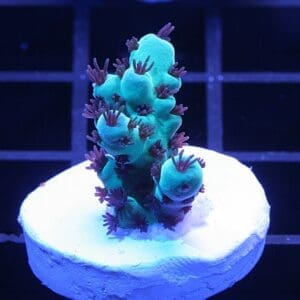Lemon Lime Acropora Millepora
$49.99
Coral fragments are approximately 3/4-1″ inch and encrusted onto a ceramic plug or disk.
Out of stock
Out of stock
This Acropora Millepora was given to us as a sunset millepora around 2015 for it’s ultra lemon lime green color. I have never seen it produce real sunset colors in any of our systems. The coral does get a super light ultra bright green in shades of yellow so we gave it a Lemon Lime name. The coral grows out in a table structure giving it great form with good polyp extension and color. DocAquarium likes to use this coral in most aquarium builds. Aquarium maintenance for this coral is easily handled by cutting back branches growing outward from the outter edge.
Acropora Millepora Coral grows out in a table like structure with an ever so slight outward curved top. Each branch is covered in polyps and each polyp can get long polyp extension giving the coral hairy look. The extended polyps will wave around with the flow and the polyp extension depends on the coral’s health. The Limeade millepora gets its name from the green body with shades yellow.
One of the more challenging corals due to the fact chemistry levels need to be stable in order for this coral to do well. Regular testing of alkalinity and calcium are required. Flow needs to be alternating and strong. The colors will look great with good lighting, flow and certain nutrient levels.
Lighting: medium high – strong lighting 150-450 PAR.
Flow: medium – high
Care Level: intermediate- advanced
Original Location Range: Indonesia, Coral Triangle, South Pacific
Grown in our California coral farm where we provide zero impact corals
Water chemistry Calcium 400-450, Magnesium 1350, KH 7-9.5, pH 8.1-8.4, Nitrates .01-10, Phosphates .01-.1 salinity 1.026
Temperature Range: 74- 81 Fahrenheit
Dosing: Doc highly recommends automated dosing of Ca, Kh and other elements to provide ultimate stable water chemistry throughout the day. It is important there are no large fluctuation swings especially with Kh/alkalinity. For more information on dosing and products click here.
:
Placement recommendations: Acropora coral will do best in the upper 1/3 of the aquarium where light and flow is high. Best to have alternating flow in a back and forth motion.
Attachment: Use epoxy and reef glue or just reef glue for smaller fragments. Clip off as much of the plug or disc possible. Add a small amount of coral glue to the underside of the disk. Mix up enough two part epoxy to create a small mound and dab it a few times into the glue to get it tacky then press and mold a conical shape. Add a few small daps to the tip of the cone dabbing the glue so it really sticks to the epoxy. Press the coral disk onto the desired location and press the epoxy flat around the disk. Be sure the coral is fully secure, the coral should never fall off the reef.
Click here for our favorite epoxy and reef glues.
Trouble shooting: Acros can and will brown out easy especially went first added to a new environment. Do not be alarmed if your colorful Acropora fragment browns out for a while. They will also brown out from any unstable levels, keeping consistent water parameters is best for the coral. Pests like acropora eating flatworms aka aefw will cause the coral to brown out and stress out. Keep an eye out for slow tissue necrosis and rapid tissue necrosis.
| color | Blue |
|---|




Reviews